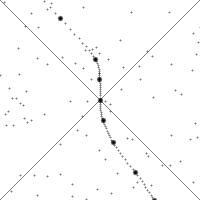 |
This is a featured picture on English Wikipedia and is considered one of the finest images.
- If you think this file should be featured on Wikimedia Commons as well, feel free to nominate it.
- If you have an image of similar quality that can be published under a suitable copyright license, be sure to upload it, tag it, and nominate it.
|
 |
Changing views of spacetime along the world line of a rapidly accelerating observer
In this animation, the vertical direction indicates time and the horizontal direction indicates distance, the dashed line is the spacetime trajectory ("world line") of an accelerating observer. The small dots are arbitrary events in spacetime that are stationary relative to each other. The events passing the two diagonal lines in the lower half of the picture (the past light cone of the observer) are those that are visible to the observer.
The slope of the world line (deviation from being vertical) gives the relative velocity to the observer. Note how the view of spacetime changes when the observer accelerates. In particular, absolute time is a concept not applicable in Lorentzian spacetime: events move up-and-down in the figure depending on the acceleration of the observer.
Compare this to the absolute time apparent in Image:Galilean transform of world line.gif.
 |
Permission is granted to copy, distribute and/or modify this document under the terms of the GNU Free Documentation license, Version 1.2 or any later version published by the Free Software Foundation; with no Invariant Sections, no Front-Cover Texts, and no Back-Cover Texts. A copy of the license is included in the section entitled " GNU Free Documentation license".
Aragonés | العربية | Asturianu | Беларуская (тарашкевіца) | Български | বাংলা | ইমার ঠার/বিষ্ণুপ্রিয়া মণিপুরী | Brezhoneg | Bosanski | Català | Cebuano | Česky | Dansk | Deutsch | Ελληνικά | English | Esperanto | Español | Eesti | Euskara | فارسی | Suomi | Français | Gaeilge | Galego | עברית | Hrvatski | Magyar | Bahasa Indonesia | Ido | Íslenska | Italiano | 日本語 | ქართული | ភាសាខ្មែរ | 한국어 | Kurdî / كوردی | Latina | Lëtzebuergesch | Lietuvių | Bahasa Melayu | Nnapulitano | Nederlands | Norsk (nynorsk) | Norsk (bokmål) | Occitan | Polski | Português | Română | Русский | Slovenčina | Slovenščina | Shqip | Српски / Srpski | Svenska | తెలుగు | ไทย | Tagalog | Türkçe | Українська | اردو | Tiếng Việt | Volapük | Yorùbá | 中文(简体) | 中文(繁體) | +/- |
Source of program used to generate image:
//GPL
#include <stdio.h>
#include <stdlib.h>
#include <math.h>
#define PI 3.141592653589793238462
#define SX 200
#define SY 200
#define PL 100
#define DN 2000
unsigned char img[SX][SY];
double path[PL+1][2], dots[DN][2];
void dodot(int x, int y, double f) {
if(x<0||x>=SX||y<0||y>=SY) return;
img[y][x]*=f;
}
void dospot(int x, int y) {
dodot(x, y, .5);
dodot(x+1, y, .75);
dodot(x-1, y, .75);
dodot(x, y+1, .75);
dodot(x, y-1, .75);
}
void dobigspot(int x, int y) {
int a, b;
for(b=-3;b<=3;++b) for(a=-3;a<=3;++a) if(a*a+b*b<=9) dodot(x+a, y+b, (a*a+b*b)/10.);
}
void dospotd(double t, double x) {
dospot((x+1)*(SX/2.), (-t+1)*(SY/2.));
}
void dosmallspotd(double t, double x) {
dodot((x+1)*(SX/2.), (-t+1)*(SY/2.), .25);
}
void dobigspotd(double t, double x) {
dobigspot((x+1)*(SX/2.), (-t+1)*(SY/2.));
}
int main() {
char fn[100];
int n, x, y, t, i, w;
double a, b, da, db, ta, tb;
FILE *f;
path[0][0]=path[0][1]=0;
for(t=0;t<=PL;++t) path[t][1]=0;
for(n=1;n<10;++n) {
a=rand()%20000/10000.-1; a/=n*n*n*n/200.; b=rand()%20000*(PI/10000);
for(t=0;t<=PL;++t) {
path[t][1]+=a*sin((2*PI/PL)*n*t+b);
}
}
for(t=PL;t>=0;--t) path[t][1]-=path[0][1];
path[0][0]=0;
for(t=1;t<=PL;++t) {
a=path[t][1]-path[t-1][1];
path[t][0]=path[t-1][0]+sqrt(1+a*a);
}
for(t=0;t<DN;++t) {
a=rand()%20000/10000.-1; b=rand()%20000/10000.-1;
dots[t][0]=a*path[PL][0]/2; dots[t][1]=b*1000;
}
for(n=0;n<100;++n) {
i=PL*n/100;
a=path[i+1][0]-(da=path[i][0]); b=(db=path[i][1])-path[i+1][1];
ta=path[PL][0]; tb=path[PL][1];
a/=50.; b/=50.;
for(y=0;y<SY;++y) for(x=0;x<SX;++x) img[y][x]=255;
for(y=0;y<SY;++y) img[y][y*SX/SY]*=.5;
for(y=0;y<SY;++y) img[y][(SY-y-1)*SX/SY]*=.5;
for(w=-20;w<=20;++w)
for(t=0;t<PL;++t) dospotd(a*(path[t][0]-da-w*ta)+b*(path[t][1]-db-w*tb),
b*(path[t][0]-da-w*ta)+a*(path[t][1]-db-w*tb));
for(w=-20;w<=20;++w)
for(t=0;t<PL;t+=10) dobigspotd(a*(path[t][0]-da-w*ta)+b*(path[t][1]-db-w*tb),
b*(path[t][0]-da-w*ta)+a*(path[t][1]-db-w*tb));
for(w=-20;w<=20;++w)
for(t=0;t<DN;++t) dospotd(a*(dots[t][0]-da-w*ta)+b*(dots[t][1]-db-w*tb),
b*(dots[t][0]-da-w*ta)+a*(dots[t][1]-db-w*tb));
//if(n==0) printf("%lf; %lf, %lf, %lf; %lf, %lf, %lf, %lf, %lf\n", a*(path[PL][0]-da-1*ta)+b*(path[PL][1]-db-1*tb), path[PL][0], da, 1*ta, path[PL][1], db, 1*tb, path[0][0], path[0]);
sprintf(fn, "lor%04d.pgm", n);
f=fopen(fn, "wb");
fprintf(f, "P5\n%d %d\n255\n", SX, SY);
fwrite(img, 256*256, 1, f);
fclose(f);
}
}
Click on a date/time to view the file as it appeared at that time.
The following pages on Schools Wikipedia link to this image (list may be incomplete):

